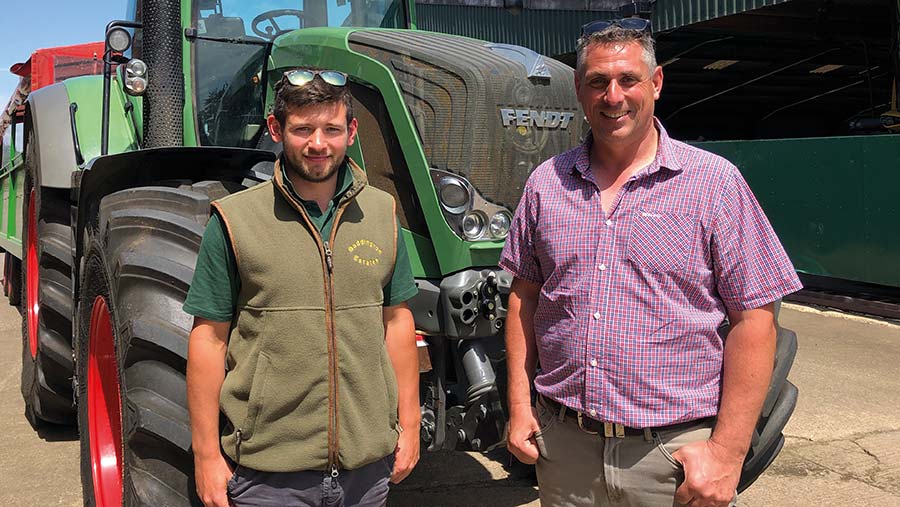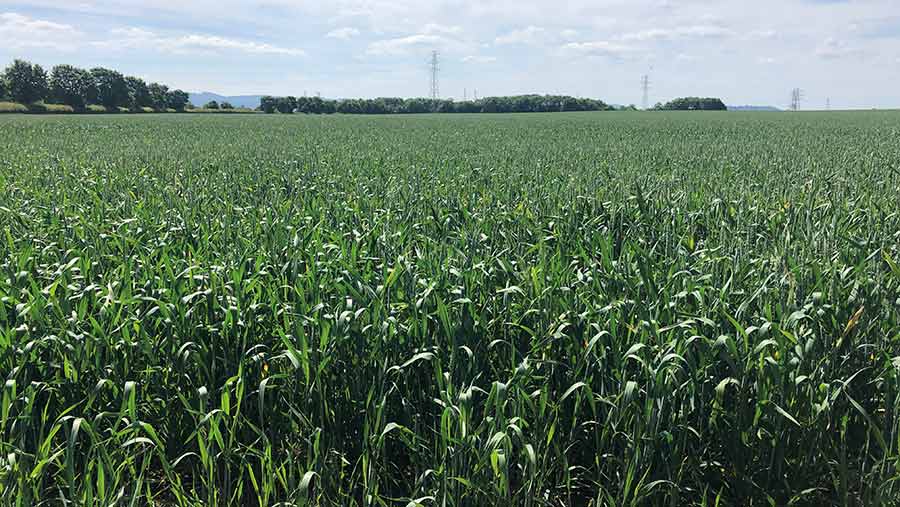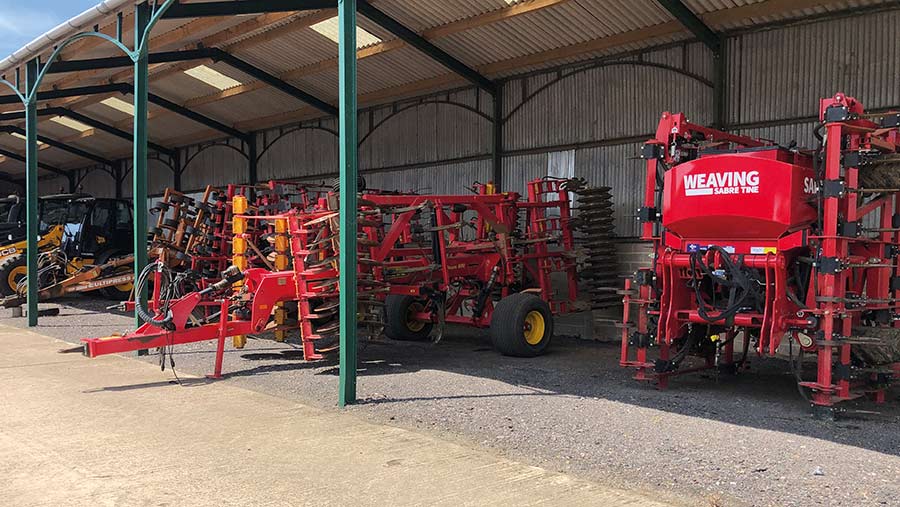AHDB Monitor Farm host sets out plan to tackle blackgrass
 Matthew Rose and Andrew Walters © MAG/Emma Gillbard
Matthew Rose and Andrew Walters © MAG/Emma Gillbard Andrew Walters, farm manager at Boddington Estates near Cheltenham is the latest to join the AHDB’s Cereals and Oilseeds Monitor Farm network, which he hopes will help tackle an ongoing blackgrass threat, and aid the transition into direct drilling.
Mr Walters took on the role of farm and estate manager at the 500ha estate owned by the Hitchins family back in 2014 and has implemented a number of changes to significantly improve the profitability of the business.
With a new team of staff and machinery switch-up, he is keen to drive the business forward.
Assisted by the estate’s arable operator Matthew Rose and the wealth of knowledge available through the AHDB programme, his aim is to reduce input costs and introduce more spring and cover crops.
See also: How costs are falling for one regen farmer
Spring cropping
The 400ha of arable land is predominantly heavy Evesham clay. Winter cropping has dominated at the estate, as such heavy clay soils often make land difficult to access during the spring.
The typical rotation would include winter barley, winter oilseed rape, winter wheat and winter beans, and consequently a high influx of blackgrass has built up.
With an ongoing blackgrass challenge, ploughing, rotational leys and fallow have all formed part of the farm’s management plan.
Grass leys for the farm’s 130-head of Stabiliser cattle often follow high-pressure weed fields, but more action needs to be taken.
In fact, Mr Walters had to take out one winter barley field and replace it with spring wheat as infestation levels were so high.
“Planted on 15 September, the barley looked well but after Christmas 70% of the field was infested with blackgrass.
“It was a complete carpet so we had to start again. We brought sheep in to graze the barley down and then sprayed the crop off in February, before drilling with a Horsch Avatar demonstrator drill in March,” he says.
Fortunately, blackgrass levels have significantly reduced on the field, which will follow with a five-year herbal ley to reduce pressure further.
Mr Walters now plans to take a more proactive approach to spring cropping and reverse the estate’s mindset that spring crops are less profitable.
He had tried growing canary seed and linseed, but both crops had various challenges. Through sharing knowledge and ideas from the Monitor Farm programme he hopes this will change.
“I look forward to welcoming people to the farm, sharing my thoughts and to use this process to learn from other farmers.
“I am very keen to move the farm forward here at Boddington and interacting with like-minded farmers can only be a positive,” he adds.
Wheat and sheep

© MAG/Emma Gillbard
This season, a sheep-grazing trial was carried out on wheat and barley crops throughout the winter to identify potential cost savings of fungicides and plant growth regulators and any other crop benefits.
A local neighbour’s sheep grazed the fields in February to help reduce disease pressure.
Mr Walters was pleasantly surprised with how successful the trial was, removing the diseased leaves with clean regrowth – so much so that he is now considering bringing sheep back on to the farm.
“The sheep grazing was fantastic and crops are now looking notably greener, with significantly more healthy leaves that will hopefully build more yield.
“We are thinking there will be greater straw yield where the sheep have been as well.”
The grazing was so effective that a T0 fungicide was no longer required. Instead, it was replaced with a copper, boron and manganese nutrient trace element spray, applied after tissue testing analysis.
At T1 a dose of sulphur was applied to see if it could hold back the powdery mildew that was beginning to take hold. Unfortunately, it couldn’t control the disease, so a multi-site spray followed.
T2 was Elatus Era (benzovindiflupyr and prothioconazole), followed by a standard T3 application of tebuconazole and prothioconazole.
Cultivation cuts
Cultivation techniques across the estate were historically based on a min-till system, with a low-disturbance subsoiler and Vaderstad Topdown.
Drilling is carried out with a Vaderstad 6m Rapid drill, backed up with a Weaving 6m Sabre tine.
Following a transition period, the farm has recently made the decision to invest in a new Horsch Avatar drill, which will arrive for the 2022 autumn drilling, to replace the 12-year-old Vaderstad.
Transitioning into direct drilling will not be a quick process and Mr Walters openly admits to a flexible approach, on a field-by-field basis.
“We still have the plough and a Topdown, so the direct drill is just a part of the jigsaw to give us greater flexibility and help us work towards our goal of moving less soil, simulating less grassweeds and reducing overall cost.
“We’re aiming for a minimum of one-third of the land to be direct drilled this season.”
Nutrition
Wheats are grown for milling, with Crusoe being the variety of choice.
Crops normally receive 240kg N/ha of liquid fertiliser to achieve milling spec, but with this year’s input inflation 215kg N/ha was applied in the standard three splits, followed up with a Nufol protein dressing.
“With the grain price and premiums the cost of nitrogen still stacks up, but we’re looking at ways to reduce our reliance on artificial fertiliser.
“The use of manure has certainly helped, as well as the adoption of tundra winter beans into the rotation,” he says.
Most of the grain is marketed through Openfield, Frontier and Cefetra. Traditionally, pools were used in the sales strategy, but in recent years spot marketing and forward contracts were favoured.
Most straw is baled, with the cleanest blackgrass fields kept back for the farm’s own livestock bedding and feed.
Machinery set-up

© MAG/Emma Gillbard
When Mr Walters became farm and estate manager in 2014 he invested heavily in machinery as part of a planned overhaul of the farming operation.
Today all machinery is owned, with a policy of buying the correct machine for the job. He has set up a comprehensive machinery replacement plan to avoid costly repairs.
Current machines on-farm are:
- Fendt 828, with TopCon RTK guidance (2014)
- Valtra T234 with RTK guidance (2018)
- Valtra T174 with front-end loader (2021)
- New Holland TS110 (stock enterprise) (2002)
- New Holland CR8.90 combine with 30ft header, RTK guidance, yield mapping (2016)
- JCB TM320S telehandler, (2022)
- Fendt Rogator SP sprayer, 5000-litre tank, 36m booms. Individual nozzle shut off, RTK guidance, one set of wheels all year round (2019)
- John Deere Gator, (2014) 6m demount sprayer
- Vaderstad Topdown (2011)
- Heva 5 Leg low-disturbance subsoiler (2020)
- Vaderstad NZA spring tine 6.0m, (2013)
- Simba 4.6m Cultipress
- Horsch Avatar 6m drill, triple hopper plus mini drill (2022)
- Weaving 6m Sabre Tine drill (2020)
- 4m Kuhn power harrow drill combination
- Kuhn 40.1 fertiliser spreader
- Dalbo 12.2m Cambridge rolls with breakers and front cracker board
- Proforge single leg mole plough (2021)
- Kverneland five-furrow plough
- 2 x K-Two 14t grain trailers
- 1 x K-Two 16t grain trailer
- McConnel SR460 topper
- Shelbourne Reynolds 8065VFR hedge cutter (2022)

